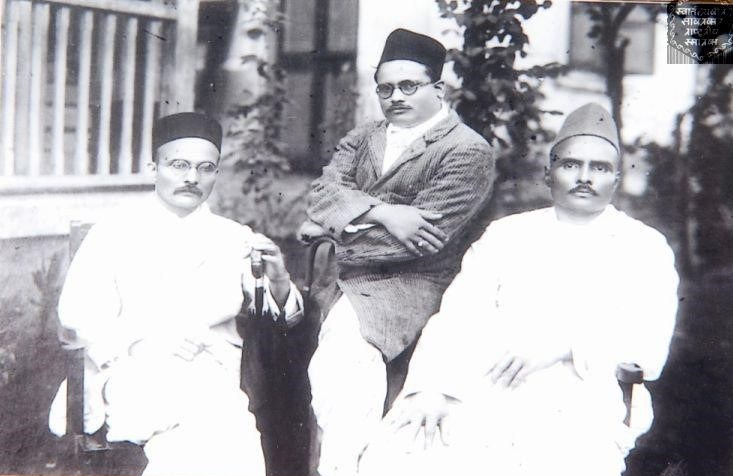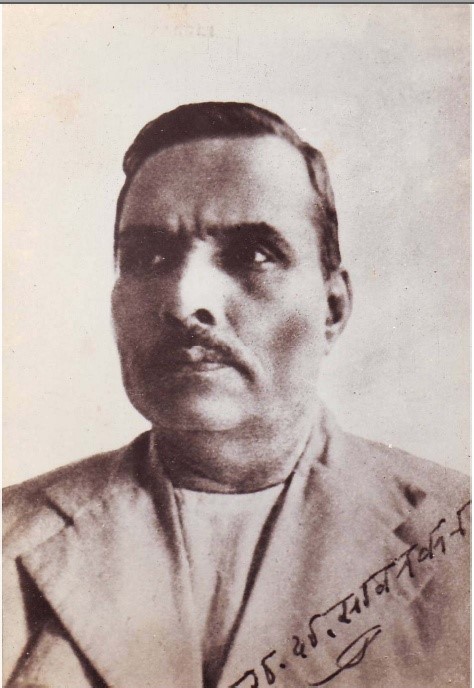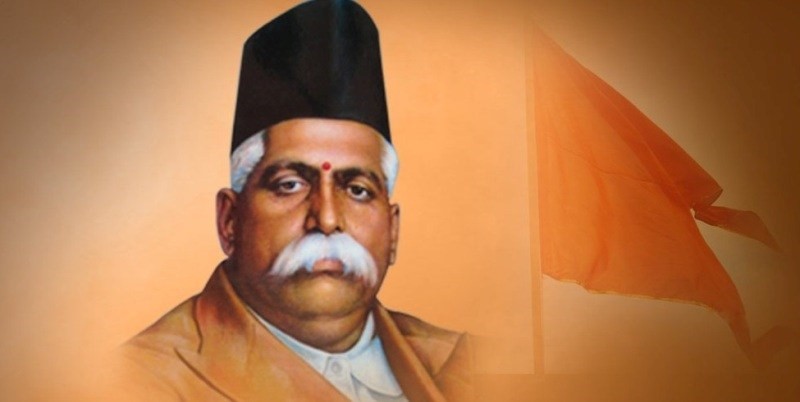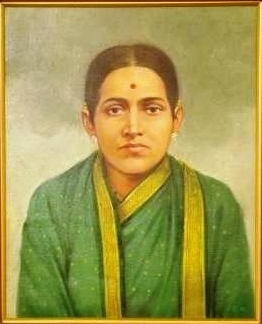A Tribute to an Unsung Hero
By Niranjan Gurram

The course of post-independence Indian politics led to many of the heroes of the motherland to be forgotten in time. One of them was Ganesh Damodar Savarkar, a great revolutionary, thinker and writer, an exemplary character of Hindu nationalism, who is commonly known in his native Maharashtra as ‘Babarao’. It is an inspirational story which needs to be told. A true karmayogi, Babarao changed the course of national life along with his famous brother Vinayak Savarkar through the revolutionary movement under the banner of Abhinav Bharat and the Hindutva movement. It is through these forerunners of unified Hindu awareness that this great nation has been enlightened about its sanskriti (culture) and sabhyata (civilisation).

The Savarkar family lived in Bhagur village near Nashik, Maharashtra, where Babarao was born on June 13, 1879. The brothers lost their parents early. Mother, Radhabhai, died when Ganesh was thirteen and few years later their father, Damodar Pant died in a plague epidemic. The responsibility of the family fell on the shoulders of Babarao which he fulfilled quite admirably by raising his younger brothers Vinayak and Narayan. Out of his love and sense of duty towards his younger brothers he gave up education to cope with his difficult financial situation. These family responsibilities and extended mimansa[1] over choosing between a spiritual path or the nation, had initially restricted his efforts in the revolutionary movement. However, he actively participated in the movement during the partition of Bengal which took place in 1905. In 1906, the responsibility of ‘Abhinav Bharat’, an organisation founded by his better known younger brother Vinayak, fell on the shoulders of Babarao when the latter departed to London to further the objective of Indian independence from the oppressor’s home territory under guise of education. ‘Swaraj’ (self rule) and absolute political freedom was the motto of Abhinav Bharat. R. C. Majumdar says:
“Many colleges and higher education institutions in Poona and Bombay had at least one secret society branch of Abhinav Bharat. The young men, thus saturated with revolutionary ideas went away after completing their education and became the leaders in their own towns and cities and started branches of Abhinav Bharat in Maharashtra, Carnatic and Madhya Pradesh. Members of Abhinav Bharat held important posts in government services in all the three zones and some even in the secretariat of Delhi. They also established contact with Bengal”.
Babarao regularly invited the then leading torch bearers of the freedom movement and great Hindu thinkers like Sri Aurobindo Ghosh, Lokmanya Tilak, Adv. Deshpande, S. M. Paranjpe (editor of ‘Kaal’) etc. to deliver lectures at meetings of young members of Abhinav Bharat. Abhinav Bharat organised processions on occasions like Dussehra and Shivaji Jayanati where members would raise slogans of ‘Swatantryalakshmi ki Jai’, ‘Shivaji Maharaj ki Jai’. On one such occasion of Dussehra, in a procession of Abhinav Bharat organised at Kalika Mandir, Babarao and others raised slogans of ‘Vande Mataram’ which caused the British residents of that place to complain to the Police. The police arrived and in the scuffle a British police officer struck Babarao hard on the head. An enraged Babarao retaliated by catching his throat and thrashing him. Babarao along with other revolutionaries were arrested and put on trial before the First Class Magistrate of Malegaon division, W. Plunkett. The trial which dragged on for an year became famous throughout Maharashtra as the ‘Vande Mataram trial’.
On June 24, 1908 ‘Lokmanya’ Bal Gangadhar Tilak was arrested for writing an article ‘Deshache Durdaiva’ (The country’s misfortune) and lodged in Dongri jail in Mumbai, where Babarao too was serving a month-long sentence of rigorous imprisonment. Babarao seized the opportunity to initiate a conversation with Lokmanya Tilak. He asked Tilak, “Balwant Rao, now you are arrested, what will happen to Maharashtra?” Tilak’s memorable reply was “Baba, don’t worry about Maharashtra. If Maharashtra is alive, it will not die with one man less. And if it is dead, one man alone cannot bring it to life. So why worry?” The meeting was an only one between them as Babarao was soon shifted to Thane jail, and Tilak was transported to Mandalay, Burma to serve a six year sentence pronounced on him. But the Tilak’s words remained with Babarao throughout his life.
Though released after a month in jail, Babarao was under constant surveillance of police sleuths. They kept a close track on his moves and those of Pandurang Bapat, who had returned from London. Bapat taught Babarao techniques of bomb-making, which he had learnt in Russia on the advice of Vinayak Savarkar. As the police made Babarao’s life increasingly difficult he had to repeatedly keep moving from different streets to other towns to put them off his trail, in a game of hide and seek that lasted 7-8 months. In that period, Babarao succeeded in teaching the young revolutionaries ways of bomb-making in almost every branch of Abhinav Bharat, which had by now set up cells in most corners of Maharashtra. The influence of Babarao’s revolutionary ideas spread to other regions of India like Bengal, Punjab and Madras. Vinayak Savarkar in the meanwhile sent arms to him from London through his colleague Chaturbuj. He had gone underground after receiving one such consignment, but ran out of luck when on February 28, 1909, apprehended when he was holding a meeting with another member of Abhinav Bharat and his cousin, V. M. Bhat. He was arrested and on the way being taken to Nashik Jail, an officer asked him in a preliminary interrogation “…so, you intend to overthrow the British, but how do you plan to go about it?” Babarao’s reply left him astounded:
“The British have promised to grant us freedom when we became worthy of it. So we plan to make ourselves worthy by intensifying our desire for freedom. Then British will themselves grant us freedom. This is in fact what they have promised.”
Charged under sections 121 (aiding and abetting treason against the King) and 124A of the Indian Penal Code, in the Judgement pronounced on June 8, 1909, Babarao was sentenced to transportation for life to the Cellular Jail in Andamans. All his properties were to be confiscated under section 121 and under section 124A awarded a sentence of two years rigourous imprisonment for publishing anti-king and anti-British literature (among them, the series of poems titled ‘Laghu Abhinav Bharat Mala’). In order to demoralize and strike fear in the hearts of the residents of Nashik, among whom Babarao was one of the most respected figures, the British authorities paraded Babarao in fetters through the streets of the city with his hands and feet in handcuffs, and made to wear a yellow cap on his head signifying the menacing horrific punishment of kalapani. The dread of the British authorities was such that no one came to Nasik station to see off Babarao.
Retaliations at Babarao’s arrest
As the Bombay high court confirmed the verdict of the lower court, news of Babarao’s imminent deportation to Cellular Jail in Andaman reached India House at London, which had become the hot bed of revolutionaries under the leadership of Vinayak Savarkar. The news agitated the revolutionaries and a few days later, on July 1, 1909 Madanlal Dhingra, a close associate of Vinayak Savarkar, assassinated Sir Curzon Wylie at a public meeting in London. In his confessional declaration Dhingra said, “I attempt to shed English blood as humble revenge for the inhuman hangings and deportations of patriotic Indian youths”. He was hanged for killing Wylie. (Dhingra was referring to the deportation of Ganesh Savarkar.)
Another group called ‘Karve group’ consisting of Krishnaji Gopal Karve, Vinayak Narayan Deshpande and Anant Kanhere of Nashik, plotted the murder of Mr. Jackson, the District Magistrate of Nashik, as he was seen as being instrumental in the deportation of Babarao, and also since on another occasion he had reprived one Mr. Williams, a British engineer who had caused the death of an Indian farmer through rash and negligent driving. The group assassinated Jackson at Vijayanand theatre in Nashik on December 21, 1909. Kanhere, who was then a 19-year old student from Aurangabad, said in his declaration: “I have done my duty… was instrumental in the deportation of G. D. Savarkar and in shielding executive engineer Williams who was involved in an Indian farmers death. I therefore killed Jackson, I don’t wish to escape.” Kanhare and his associates Karve and Deshpande smilingly went to the gallows on April 19, 1910 at Thane jail. Thus it can be seen the resentment was tremendous among the young revolutionaries inspired by Babarao against the British authorities.

Life at Cellular Jail, the Andaman Islands
In 1910, Babarao was transported to the cellular jail in Andamans, infamous for torturous treatment of prisoners. For most of his time Babarao was yoked in ‘kolhu’[2] subjected to this arduous form of labour throughout the day, as ordered by the notoriously sadistic Irish jailor, David Barry. He was also subjected to the excruciating standing handcuffs[3] as punishment.
Most of the jail’s petty overseers were Muslims who had no fellow-feeling for the independence activists and would prove their loyalty to Barry by compounding the miseries of the freedom fighters by contaminating and curtailing their food. They would add kerosene to their food while cooking which caused painful stomach ailments to the prisoners and bloody stools, and Babarao also fell victim to it. Prisoners were coerced to convert to Islam in order to escape the unremitting tortures meted out by the petty officers of the jail. Babrao led the prisoners to protest and revolt against the daily torture carried out by the Muslim wardens with Barry’s countenance. The prisoners were not allowed to interact with each other and the vigilance and terror was such that Vinayak Savarkar, who had been subsequently transported to cellular jail on July 4, 1911 could interact with Babarao inside the jail in person only after two years the brothers were in the forefront of revolts against the barbaric treatment meted out to the political prisoners by Barry and the Muslim wardens.
By the end of 1919, Babarao’s health had considerably deteriorated owing to the travails and maltreatment at the jail and his weight had dropped to under 45 Kilograms. He was diagnosed with Tuberculosis. The basic right of proper medical treatment and time for recuperation were denied to him, even though his own brother Vinayak Savarkar and other political prisoners were sent to hospital for their ailments.
In 1921, after sustained pressure of Indian public opinion, which included a memorandum with 70,000 signatures and advocacy by Indian political leaders like Bal Gangadhar Tilak and Surendranath Banerjee, the British Government of India decided to transfer the Savarkar brothers to a jail in mainland India. In their farewell address to the jubilant fellow prisoners who celebrated their release from Andaman Jail, Vinayak Savarkar’s message was:
“Ek dev, ek desh, ek aashaa,
Ek jaati, ek jeev, ek bhaashaa”
(One belief, one nation, one race, one language, unified hope and a unified being!)
The brothers were brought to Calcutta and sent to Alipore Jail. From there, Babarao was sent to Bijapur jail where he was kept in solitary confinement for the next eight months. Thereafter he was shifted to Sabarmati jail in January 1922. In Sabarmati jail, in the course of his interactions during evening walks with another inmate, Maulana Hasrat Mohani, a Islamic leader, he became aware of the conspiracy of pan-Islamists to invite Amir-Amanullah of Afghanistan to invade Hindustan and the pact between Gandhi and Amanullah. He became restive to become free again so that he could travel throughout the country and make people aware of this plot. However he had become so weak that the authorities hospitalised him, assuming that he would die in few days. Due the active efforts of the Sindhi leader, Jairamdas Daulatram, and Babarao’s younger brother, Narayan Savarkar, who had written to the province administrator regarding his ill-health, and apprehensive of public wrath in case Babarao died, the authorities were constrained to release him in September 1922, after spending 13 years in prison under harrowing conditions.
Exposing ‘Gandhism’ and Hindu Consolidation through Tarun Hindu Sabha and Rashtriya Swayamsevak Sangh
After his release from prison, Babarao devoted himself to the task of awakening the Hindu society by against forces during those times subverting the Hindu nation. He began to question the Gandhian notion of extreme truth and non-violent politics. He was of the conviction that successfully achieving the political aims of the Indian people needed hard-headed realism, on the lines of the principle of ‘shatham prati shathyam’ (wily in requital; tit for tat).[4] Babarao felt that the false, misplaced notions that M. K. Gandhi propagated had hampered the nationalist movement. Further, he believed that it was naive to think self-flagellation of natives would move the British to abandon their profitable rule over India. He also disagreed with Gandhi’s romantic idea of Hindu-Muslim unity. Gandhi insisted that self-rule was not possible without fabled Hindu-Muslim unity and went to an extent of saying that he would give up self-rule for the sake of Hindu-Muslim unity. Babarao believed from his practical experience that this was an unrealisable goal that would jeopardise the quest of independence.
Babarao wanted to awaken consciousness of Hindus towards their civilisation and was resolved to create a constructive alternative to the self-defeating Gandhian ideology. He began to participate in the activities of the Hindu Mahasabha and established in 1923-24 an organisation called ‘Tarun Hindu Sabha’ (Young India conference) for the Hindu youth. For the next four to five years, he travelled extensively and established about thirty branches of Tarun Hindu Sabha and enlisted more than five hundred youths into its fold. It was open for all Hindus between the age of 16-40 years and would aimed at unity among Hindus. They would participate in shuddi movement[5], combat caste-based discrimination and render training in self-defence. Tarun Sabha volunteers would also participate in activities of the Hindu Mahasabha.

Dr. Keshav Baliram Hedgewar, a former member of the revolutionary organisation, Anushilan Samithi, met Babarao when he was stayed at the Nagpur residence of Adv. Vishwanath Rao Kelkar, his associate during the days of Abhinav Bharat. Babarao wanted to entrust the responsibility of the Nagpur unit of Tarun Sabha to Dr. Hedgewar. However, on the occasion of Vijaya Dashami in 1925, which was to become later a historic moment, Dr. Hedgewar started a ‘shakha’ with Hindu youths in Nagpur. This was the beginning of the Rashtriya Swayamsevak Sangh (RSS). Babarao, who was present in Nagpur during that occasion, was happy to know that a new Hindu organisation had been formed which aimed at uniting Hindus. Dr. Hedgewar had great regard for Babarao and would frequently consult him on various issues related to the goals and running of RSS. Dr. Hedgewar asked Babarao to prepare a pledge for RSS, as the latter had also drafted the formal oath for Abhinav Bharat and Tarun Sabha. The final pledge included the words ‘Hindu Rashtra’, and this was the first time that these words were included in any organisation’s official doctrine.
Considering his own health and the need for a pan-Hindu organisation, Babarao decided to disband the Tarun Sabha and merge it with the newly formed RSS which held forth the same aims and objectives.[6] After the merging of Tarun Hindu Sabha with the Sangh in 1932, Babarao accompanied Dr. Hedgewar on a tour to the nooks and corners of Maharashtra for the expansion of the Sangh network. Babarao Savarkar devoted the remainder of his life to the Sangh.[7]
Babarao had studied Ayurveda, Samudrika Shastras, Astrology, Yoga and Vedanta. In spite of his limited education he had vast knowledge on a wide variety of topics. His first book written in Marathi was ‘Rashtramimansa va Hindusthanche rashtraswaroop”.[8] Another significant work by Babarao’s was ‘Hindu Rashtra – poorvi, aataa aani pudhe” (Hindu Nation – past, present and future).[9] He had also put out a rather disputable thesis in a book on Jesus Christ named ‘Christ Parichay’ wherein he opined that Christ had been a Hindu by birth.[10]
V D Savarkar and Ganesh Damodar Savarkar- A comparison of Krishna-Balarama

Vinayak Savarkar and Ganesh Savarkar were brothers but they had in many ways contrasting personalities. V. D. Savarkar was an atheist. His philosophy had the elements of utilitarianism, rationalism and realism, whereas G. D. Savarkar had a religious bent of mind and would spend long hours in puja and religious activities. While Vinayak Savarkar was inspired by the Joseph Mazzini and Samarth Ramdas, Babarao’s chief source of inspiration was Swami Vivekananda and Ramatirtha. G D Savarkar was the Balrama who always stood behind his genius younger brother ‘Krishna’ Vinayak Savarkar. Babarao’s family life had been reduced to ruins as his children died in their infancy and his caring wife, Yashoda (Yeshubai) died when he was in Andaman Jail. He dedicated everything for his nation and he stood like a rock behind his brothers in their efforts to make India independent. On deathbed in Sangli, Maharashtra, his brother Vinayak sat by his side and said to him:
“Baba, we three brothers had a common life-mission. We have repaid our ancestors in our generation. When the history of Bharat is written, a chapter will have to be necessarily written in letters of gold. Detractors have called it ‘Savarkar yuga’.”
Few days after this meeting, Babarao passed away on March 16, 1945.
Babarao gained nothing in material terms in his pursuit for his nation, but suffered pain all his life. His contribution to the motherland and Hindu consciousness has been forgotten not only by the detractors but also by many proponents of Hindutva. But we cannot rise until we look back and remember such a great souls who have given up their lives for India’s progress into a bright future.
Cover Picture: The Savarkar Trio, from Left- Veer Savarkar, Narayan Savarkar and Krantiveer Ganesh Savarkar (Source-www.savarkar.org)
References:
- ‘Biography of Babarao Savarkar’ (Savarkar.org)
- ‘Life of Barrister Savarkar’, by Chitragupta
- ‘History of the freedom movement in India’, Volume II – R. C. Majumdar
- Hedgewar – The Epoch Maker (RSS Publication)
- ‘We or our nationhood defined’, by M. S. Golwalkar
- ‘My transportation for Life’, by Vinayak Damodar Savarkar
- ‘Inside congress’, by Swami Shraddhanand
[1] loosely, contemplation
[2] An apparatus for extracting oil from oilseeds and coconuts, with a large pestle at the centre with a projecting rod which when turned (usually with a bullock yoked to the bar) crushed the seeds in the pestle to produce oil.
[3] A shackling contraption by which prisoners were restrained in standing position.
[4] The original Sanskrit shloka reads: “शठं प्रति शठं बृयादादरं प्रति चादर्म् । तत्र दोषो न भवति दुष्टे दुष्टं समाचरेत् ॥”
(Speak the language of cunning with a deceitful individual, speak respectfully to a polite individual; there is no wrong made out in requiting wicked people in their own manner.)
[5] Reconversion of people converted to other faiths back to the Hindu Religion
[6] Babarao said to Dr. Hedgewar:
“Doctor, I’m today dissolving the Tarun Hindu Sabha. Please accept it and merge it in Sangh. I shall hence forth devote whatever energy I have to the work of the Sangh. May Sangh long live and achieve its goal. This is my benediction”.
[7] It is very sad to note that some in RSS disown Ganesh Damodar Savarkar and claim that he has nothing to do with the RSS or its formation
[8] This book is a theoretical discussion on the concept of Hindu nation and speaks about how the concept of land, community, dharma, civilisation and language are of great importance to nationhood. This book later went on to become the theoretical doctrine for Hindu organisations like RSS and the Hindu Mahasabha.
[9] This book narrates the history of Hindu nation
[10] https://www.mid-day.com/articles/jesus-christ-was-a-tamil-hindu-claims-rss-founder-s-controversial-book/16978186
